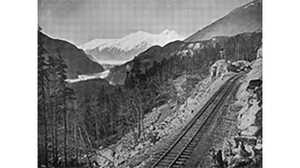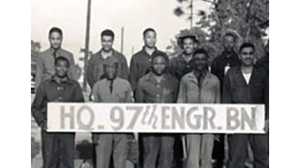The Building of the Alaska Highway
In the middle of March 1942, approximately one month after President Franklin Rosevelt authorized the highway, the Army Corps of Engineers began arriving in Alaska. More than 10,000 soldiers came with 250,000 tons of materials for their mission. Rather than proceeding from one point and in one direction, seven regiments were posted in strategic positions along the route. Building north and south, each group would eventually meet up with other units. Construction of the Alaska Highway officially commenced on April 11, 1942.

Quick Method
Their method was simple. Surveyors worked roughly ten miles ahead of the bulldozers and the men who cleared the path. The surveyors would map the exact route, and soon enough, the men behind them would catch up and blaze a path. A battalion of bulldozers cleared the way by knocking down trees in a path roughly 50 to 90 feet across. Transporting equipment across the rough terrain was difficult, and when necessary items didn't show up, the engineers would be forced to cut the trees and other vegetation by hand. Once the path was cleared, a second battalion brought up the rear, hurriedly flattening the road surface.
Muskeg and Mud
Speed was the order of the day. If the men couldn't go through an obstacle, they would go over it. The Corps was unprepared, however, for all of the challenges that they faced. Swamps of decaying vegetation, called muskeg, and seas of mud, caused by torrential spring rains, slowed progress. The surveyors tried to circumvent the muskeg but when this proved impossible, they would "corduroy" the road. Corduroying involved chopping trees down by hand, layering logs across the muskeg along the intended area of the road, and pouring fill over the logs. This was a time-consuming process, and by June, the inclement weather and conditions had taken their toll; only 95 miles of the highway had been completed in nearly two months.
Sense of Urgency
On June 3, 1942, the Japanese bombed the military base at Dutch Harbor in the Aleutian Islands, causing more than 100 American casualties. The enemy's proximity constantly reminded the men that they were at war, and gave them a renewed sense of purpose in their work. Still, hindered by the tough working conditions, the builders completed only 360 miles of road by the end of June, leaving 1,100 miles left to be built in four months before the winter deadline.
Summertime
The summer weather brought about more favorable conditions for construction, however, and within the month of July alone, the men built 400 miles of the highway. But with the summer came dust clouds, mosquitoes and high temperatures, creating a different kind of discomfort for the men of the Army Corps of Engineers.
Public Safety Campaign
In August, the Roosevelt administration began running the equivalent of a press campaign for the construction effort in Alaska, seeking to convince the public that everything was being done to assure their safety. The August 31, 1942 issue of Time magazine described the construction of the highway as a task befitting Paul Bunyan -- and an integral part of the war effort. The road was only one of the Northwest Defense Projects which also included airstrips, pipelines and extensive telecommunication lines.
Permafrost
The engineers raced against the clock. By the beginning of September, they had 460 miles left to build before winter set in. The workers ran up against yet another environmental obstacle along the west of Kluane Lake. This time, they were stymied by a long stretch of permafrost, semi-frozen ground that can thaw and turn into mud with a temperature change of a matter of degrees. None of the engineers knew much about permafrost, and for six weeks construction was halted while they improvised solutions for building over it. Eventually, the men found that the time-consuming, labor intensive task of corduroying the road and insulating the permafrost below, was their only hope of moving on.
Freezing Weather
Because of the many delays, winter arrived while construction was still underway. One of the coldest autumns ever recorded in the area, brought frigid temperatures that could freeze skin in seconds, putting the highway builders at great risk and hampering their progress. Finally, on October 25, at 4 p.m., the final gap in the Alaska Highway route was closed. A ceremony on November 20 officially marked the completion of the highway route, opening it to military traffic.
Unfinished for Years
The rough trail was a grand accomplishment, but it was not finished. The next spring many of the bridges washed out. In the next few years, the Public Roads Administration oversaw the construction of a paved roadway, employing civilian contractors. The Alaska Highway as it appears today was completed following the war.
Major Achievement
In fewer than eight months, however, the seven regiments of the Army Corps of Engineers had worked to their utmost limits to clear and lay down an astonishing 1,500 miles of highway. The men who built the highway had overcome environmental, technological and physical hardships to complete what many consider one of America's greatest construction projects.







